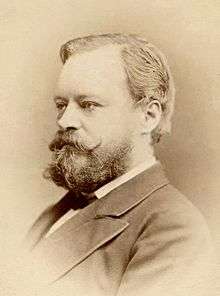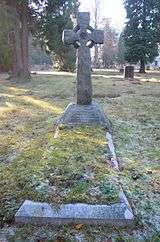Harry Seeley
| Harry Seeley | |
|---|---|
 | |
| Born |
18 February 1839 London, UK |
| Died |
8 January 1909 (aged 69) Kensington, London, UK |
| Nationality | British |
| Fields | Paleontology |
| Notable awards | Lyell Medal (1885) |
Harry Govier Seeley (18 February 1839 – 8 January 1909) was a British paleontologist.[1][2]
Career
Seeley was born in London, the son of Richard Hovill Seeley, goldsmith, and his second wife Mary Govier. He attended classes at the Royal School of Mines, Kensington before becoming an assistant to Adam Sedgwick at the Woodwardian Museum, Cambridge, from 1859. He matriculated as a student at Sidney Sussex College, Cambridge in 1863.[3] He turned down positions both with the British Museum and the Geological Survey of Britain to work on his own. Late in his career he accepted a position as Professor of Geology at King's College, Cambridge and Bedford College (London) (1876). He was later Lecturer on Geology and Physiology at Dulwich College and Professor of Geology and Mineralogy at King's College London (1896–1905).
He died in Kensington, London and was buried in Brookwood Cemetery. He had married in 1872 Eleanora Jane, daughter of William Mitchell of Bath. Their daughter Maude married Arthur Smith Woodward, FRS.
Dinosaurs

He determined that dinosaurs fell into two great groups, the Saurischians and the Ornithischians, based on the nature of their pelvic bones and joints. He published his results in 1888, from a lecture he had delivered the previous year.[4] Paleontologists of his time had been dividing the Dinosauria in various ways, depending on the structure of their feet and the form of their teeth. Seeley's division, however, has stood the test of time, though the birds have subsequently been found to descend, not from the "bird-hipped" Ornithischia, but from the "lizard-hipped" Saurischia. He found the two groups so distinct that he also argued for separate origins: not until the 1980s did new techniques of cladistic analysis show that both groups of dinosaurs really did have common ancestors in the Triassic. Seeley described and named numerous dinosaurs from their fossils in the course of his career.
His popular book on Pterosaurs, Dragons of the Air (1901), found that the development of birds and pterosaurs paralleled each other. His belief that they had a common origin has been proved, for both are archosaurs, just not as close as he thought. He upset Richard Owen's characterization of the pterosaurs as cold-blooded, sluggish gliders, and recognized them as warm-blooded active fliers.
He was elected a Fellow of the Royal Society in June 1879 for his work on reptiles and dinosaurs,[5] and delivered their Croonian Lecture in 1887.
... he will be best remembered, perhaps, for the wonderful collections he made in the Karoo Beds of South Africa and the resulting exhibition in the Natural History branch of the British Museum of the remarkable skeleton of Pareiasaurus[6] and numerous other Anomodont reptiles ....[7]
References
- ↑ Lydekker, Richard (14 Jan 1909). "Obituary. Prof. H. G. Seeley, F.R.S.". Nature. 79 (2046): 314–315. doi:10.1038/079314b0.
- ↑ "Seeley, Harry Govier". Who's Who. Vol. 59. 1907. p. 1578.
- ↑ "Seeley, Harry Govier (SLY863HG)". A Cambridge Alumni Database. University of Cambridge.
- ↑ H. G. Seeley, On the Classification of the Fossil Animals Commonly Named Dinosauria, Proc. R. Soc. Lond. January 1, 1887 43:165–171; doi:10.1098/rspl.1887.0117. See "Paper Dinosaurs" An Exhibition of Original Publications from the Collections of the Linda Hall Library.
- ↑ "Library and Archive catalogue". The Royal Society. Retrieved 11 October 2010.
- ↑ "Plate I. Skeleton of Pareiasaurus Baini, Seeley". Geological Magazine. 32. 1895.
- ↑ "Obituary. Professor H. G. Seeley". Geological Magazine. 46: 93–94. 1909.
External links
| Wikimedia Commons has media related to Harry Seeley. |
- Works by Harry Seeley at Project Gutenberg
- Works by or about Harry Seeley at Internet Archive
- Dragons of the Air (1901)
- Michon Scott, "Harry Govier Seeley"
- Harry G. Seeley